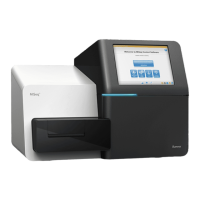Getting Started
2
Part # 15027617 Rev. A DRAFT
Introduction
The Illumina MiSeq™ Sequencing System combines proven sequencing by synthesis
technology with a revolutionary workflow that enables you to go from DNA to analyzed
data in as few as eight hours. The MiSeq integrates cluster amplification, sequencing,
and data analysis in a single instrument with a foot print of approximately two feet
square.
The MiSeq supports a wide range of applications with enhanced performance,
including the following:
} De novo sequencing
} Targeted resequencing
} Small genome sequencing
} Highly-multiplexed PCR amplicon sequencing
} ChIP-Seq sequencing
} Small RNA sequencing
} Clone checking
} Tissue typing
} Library QC
Library Preparation
You can sequence libraries prepared by one of the following sample preparation kits:
} TruSeq Sample Preparation Kit
} TruSeq Custom Amplicon Kit
} Nextera Sample Preparation Kit
Features
} Walkaway Automation—All of the reagents required for cluster generation,
sequencing, and paired-end chemistry are contained in a single reagent cartridge.
After run setup, no additional hands-on time is required.
} Prefilled Reagent Cartridge—The MiSeq uses a specially designed single-use
prefilled reagent cartridge that provides sufficient reagents for cluster generation
and 300 cycles of sequencing (2x150 paired-end run). Radio-frequency identification
(RFID) tracking enables positive consumable tracking.
} Interface Controls—The MiSeq Control Software (MCS) offers a simple interface to
configure, launch, and monitor your run, and also perform maintenance procedures
using a touch screen monitor. An integrated online keyboard can be used for
recording the ID of run components.
} Convenient Flow Cell Loading—The MiSeq single-lane flow cell is auto-positioned
on the instrument and held in place by a clamping mechanism.
} Innovative Fluidics Architecture—MiSeq fluidics architecture enables a five-fold
decrease in chemistry cycle time during sequencing.
} Real Time Analysis—The instrument software performs real time data analysis on
the instrument computer during the sequencing run, which includes image analysis
and base calling, and saves valuable downstream analysis time.

